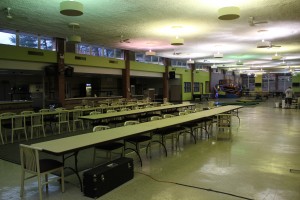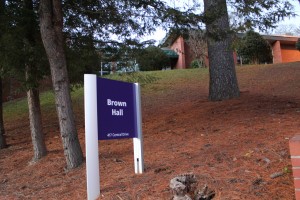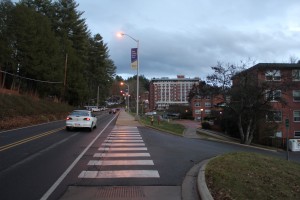Western Carolina is in its own vicious circle and is wielding a double-edged sword.
That is a minor exaggeration, but an accurate depiction as the university goes through a significant amount of change with increases in tuition and fees for the next academic year.
Students want justification for all of the increases that are to be voted on by the Tuition and Fees Committee before the end of the semester. But even with that justification, student acceptance will be in default.
Truly a double-edged sword.
The Tuition and Fee Committee proposes a 5 percent for food service fees across the board with the same meal plans in place. These mark-ups are due to food service costs of operation, benefits for its employees, and the upward trends in food cost. However, students will receive a 5 percent increase in declining balance for those meal plans due to the tuition increase.
Like residential living, food services do not receive any state funding. So, a lot had been put on Western’s plate.
And the talk surrounding campus dining has centered around the old Brown cafeteria on upper-campus.
Dr. Sam Miller, Vice Chancellor of Student Affairs, believe the Brown location is a key part to maximizing that part of campus.
“That upper part of campus that’s our historic
and original campus and we think if we make some changes, you could have a great living environment,” Dr. Miller said. “If we’re going to continue growing, then I think we need another food service location. Brown is probably too big for what we need to service the hill, but if we think of Brown in some creative ways, I think it has a lot of potential.”
It’s the thought that counts. And it will count and cost in the long-haul.
But there are steps to be taken to get to that point and it starts with research and analysis from the campus food service provider, Aramark.
Keith Corzine, Assistant Vice Chancellor of Campus Services, broke Aramark’s involvement down.
The housing and dining sides go hand-in-hand. With the university planning to implement new residential plans, the dining plans have to be coordinated in conjunction with them.
The University Center and the Courtyard Dining Hall have been servicing the 4,000 beds on campus for quite some time. With that, there have been many instances of overcrowding in the dining hall and more employees to serve all of those students.
The campus is looking to invest a lot of time and money into renovating the Brown building. But there are plenty of questions that need to be answered first.
“Our raises are strategic in nature and long term planning,” Corzine said. “Can we afford the debt? Can we provide the services and programs and pay the debt?”
Answers aren’t easy to come by, and students don’t want to wait for them either.
Here are some of the student reactions I got through Facebook.
“The quality of food and the portions are decreasing and we have to pay more, how is that fair to us?” senior communication major Kat Sumeracki said.
For junior sports management major Tony Minnicozzi the percentage of the fee increase is absurd.
“I think it is absurd how much they are wanting to increase [fees]. The food quality is poor and selection at times is dismal and they open and close as they see fit,” Minnicozzi added.
Again, the university’s primary goal is to serve the students. It is hard to see that from the outside, but a lot of things are going on internally to move forward.
Dr. Miller acknowledged Aramark is sensitive to serving students and wants to give students refreshed concepts. The market research being done in the next few months will be a step to finding alternatives. Choice and variety are two words that came up in the conversation, and Zoca and Burger Studio could be potential replacement opportunities.
Corzine even mentioned a sandwich option/venue being a possibility for the dining hall. There have even been discussions about extending the hours of Einsteins.
“Einsteins having additional hours has been one of the most frequently asked questions. We will do our best to try to accommodate that,” Corzine explained.
Only a year ago, the dining services gave Western late night dining Thursday-Saturday. Now, it carries over to Sunday.
And the Brown building is going to be that next carry-over to cater to students.
“It is critical we pick the right retail locations because not only do we want it to capture people on the hill, but we want it to be popular for some people on lower campus to want to go there.,” Corzine said. “The strategic part has been the part to be most rewarding. These decisions can possibly touch the next generation and it might span further than that.”
It is about the future, and it will be hard for current students to accept that ideology.
Starting in January, part of that future will be a 6.75 percent sales tax on student meal plans. This is a state law, and the university didn’t have any say in the matter.
Corzine sent a campus-wide email out towards the end of November addressing this change.
“During the North Carolina legislative session this past summer, tax reform bill (H998) SL 2013-316 repealed the long-standing sales tax exemption for university meal plans. Under the new law, sales tax must be charged and collected on student meals. Beginning with the spring 2014 billing, all student meal plans will be charged sales tax at a rate of 6.75% on the total amount of the plan. The new sales tax will be included in spring 2014 billing, which will be mailed in the next few weeks.
The new law also requires that sales tax be charged and collected on “point of purchase” food sales in any dining location. This applies to purchases using CatCash and all cash transactions regardless of whether you present a CatCard, which in the past eliminated the collection of sales tax.”
This garners the question, will the meal plans themselves be changing?
“As part of the market research, I think we have an opportunity over the next couple years to look at our meal plans,” Dr. Miller said. “We probably are at a point where we need to take a look at meal plans and have a conversation about that.”
As the university continues to grow, conversations will follow suit. The head of those conversations will be Chancellor David Belcher, and he will be the first to tell you that growth has to be done the right way.
“I don’t want to grow too fast,” Belcher said in an interview for WCJ. “If you grow too fast, you begin to collapse under the weight of the system.”
The Chancellor will also tell you that times are tough.
“Even though Western is one of the least expensive schools in the United States, it doesn’t matter. “In an economy like this, it’s still hard.”
And with all the constraints the state is putting on students, the last thing this university needs is to hurt itself.
Besides, the double-edged sword is already doing enough.






